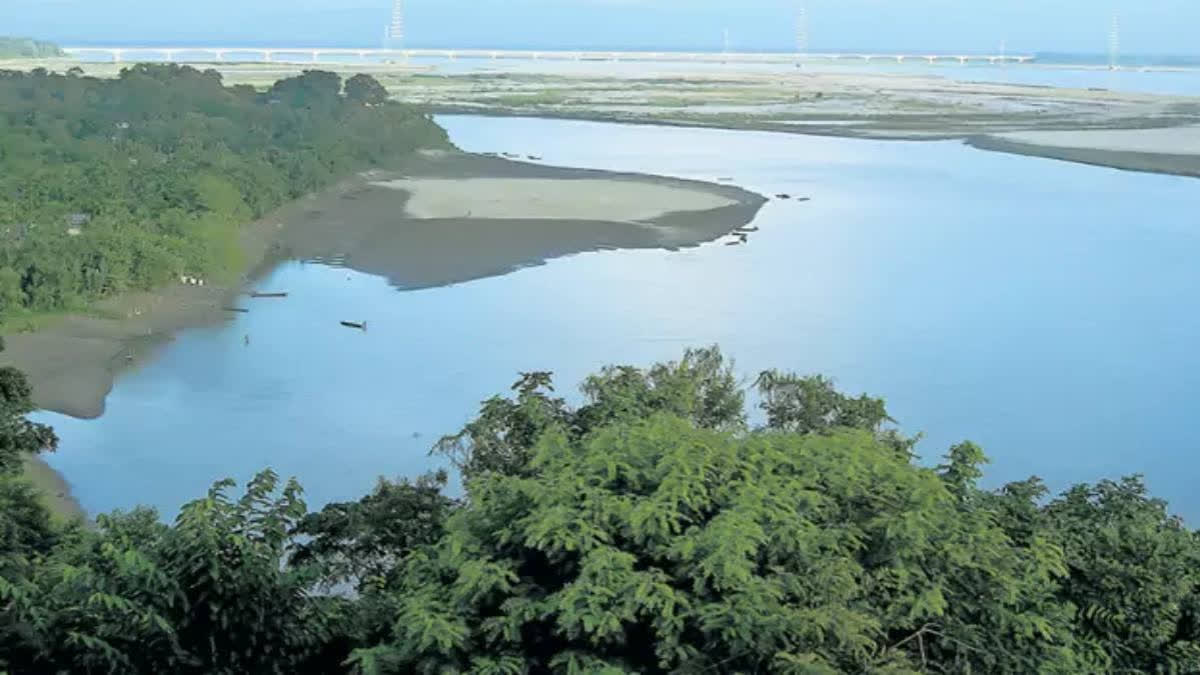New Delhi: India on Friday responded cautiously yet firmly to China’s unveiling of a major hydropower project on the Yarlung Zangbo River, known as the Brahmaputra in India, asserting its established rights to the river’s waters as a downstream nation and taking up the interests of other lower riparian states as well.
The Ministry of External Affairs reiterated longstanding concerns about the impact of such projects on the Brahmaputra River, calling for Beijing to adopt transparent practices and consult with affected countries.
"As a lower riparian state, we have established rights to the use of the waters of the river," External Affairs Ministry spokesperson Randhir Jaiswal said during his regular media briefing here. “We have consistently expressed through expert level as well as diplomatic channels our views and concerns to the Chinese side on mega projects in their territory."
Jaiswal said that India's views have been "reiterated along with the need for transparency and with consultancy with downstream countries following the latest report".
"The Chinese side has been urged to ensure that the interests of the downstream states of the Brahmaputra are not harmed by activities in upstream areas," he said. “We will continue to monitor and take necessary measures to protect our interests."
Last month, the Chinese government approved the construction of the dam on the lower reaches of the Yarlung Zangbo River, state-run Xinhua news agency reported citing an official statement. The dam, to be built at a cost of $137 billion, is expected to be the world’s largest hydroelectric project when completed and will produce nearly 300 billion kilowatt-hours (kWh) of electricity annually. That means it will generate three times the power of the Three Gorges Dam on the Yangtze River, also in China, which is currently the world's largest hydroelectric project.
Though the massive project was included in China's 14th five-year plan from 2021 to 2025, it was only last month that Beijing approved it sparking concerns among experts in India and Bangladesh, countries through which the Brahmaputra flows.
However, the Chinese foreign ministry has defended the construction of the dam saying that China has always been responsible for the development of cross-border rivers. During a regular media briefing in Beijing last month, foreign ministry spokesperson Mao Ning said that China's hydropower development in the lower reaches of the Yarlung Zangbo river " aims to speed up developing clean energy, and respond to climate change and extreme hydrological disasters".
"The hydropower development there has been studied in an in-depth way for decades, and safeguard measures have been taken for the security of the project and ecological environment protection,” Mao said. "The project has no negative impact on the lower reaches. China will continue to maintain communication with countries at the lower reaches through existing channels, and step up cooperation on disaster prevention and relief for the benefit of the people by the river."
However, the fact of the matter is that the Brahmaputra is the lifeline of Arunachal Pradesh and Assam, providing water for drinking, irrigation, and hydropower. A dam in Tibet could significantly reduce water flow during dry seasons, affecting agriculture and drinking water supply. Reduced flow could lead to silt deposition in the river, adversely affecting soil fertility in the floodplains.
India’s northeastern region is prone to flooding, particularly during the monsoon. If China decides to release water from the dam during heavy rainfall, it could exacerbate flooding in the downstream areas, causing widespread destruction of life and property.
The Brahmaputra supports extensive agricultural activities in the region. Any alteration in the river’s flow could disrupt farming cycles, impacting the livelihoods of millions of farmers. Changes in sediment transport due to the dam could affect soil quality, reducing agricultural productivity.
The Brahmaputra basin is home to unique ecosystems and diverse species, including the endangered Gangetic dolphin and various migratory birds. Altered river flow could disturb these habitats, leading to a decline in biodiversity. Fish populations that depend on the river’s natural flow for breeding could face severe threats, impacting both ecology and local fishing communities.
The northeastern states of India, particularly Arunachal Pradesh, have ambitious plans for hydropower development on the Brahmaputra and its tributaries. Reduced water flow due to upstream damming could undermine these projects, affecting India’s energy goals.
India has issues over river water sharing with Pakistan and Bangladesh. However, these issues can be resolved through dialogue as India has proper treaties in place with both these countries. With Pakistan, India has the Indus Waters Treaty, and with Bangladesh, it has the Ganga Water Sharing Treaty.
But, with China, India has no such treaty. India and China only have a memorandum of understanding (MoU) under which the Chinese side provides hydrological data on the Brahmaputra. According to experts, this is a temporary agreement that is renewed every five years and China can any time declare it null and void if it wants to.
In the wake of the reports of China's decision to construct the dam, Assam Chief Minister Himanta Biswa Sarma raised concerns saying the project will make the entire ecosystem fragile and dry. He also said the dam will make Assam dependent on rainwater from Arunachal Pradesh and Bhutan. Sarma said the Indian government has already communicated its concern to the Chinese side.
"I am sure that in the dialogue process, which is presently going on between India and China, this will be raised by the Indian side," he said during a press conference in Guwahati earlier this week.
"We have already communicated that if this dam comes then the Brahmaputra ecosystem will become fragile and dry and then we will depend on the rainwater from Arunachal Pradesh and Bhutan," he stated.
Reacting to the External Affairs Ministry’s statement on Friday, Uttam Kumar Sinha, Senior Fellow at the Manohar Parrikar Institute of Defence Studies and Analyses and a leading commentator on transboundary water issues, said that though there is nothing much to say on this, the mention of lower riparian states is significant.
"The External Affairs Ministry has said that we have been consulting this issue with China," Sinha told ETV Bharat. "The difference this time, though, is that we are mentioning the lower riparian states which include Bangladesh and Bhutan as well," he said.



